

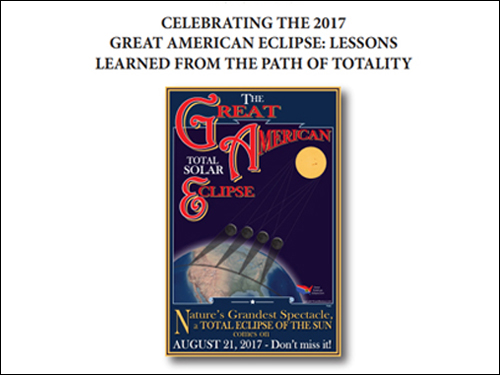
A beautiful book reviewing the historic 2017 America Eclipse was just published by the Astronomical Society of the Pacific, "CELEBRATING THE 2017 GREAT AMERICAN ECLIPSE: LESSONS LEARNED FORM THE PATH OF TOTALTIY'.
I have two articles published in the science section of the book which outline my original research and you can read them by tapping on the titles below. The shadow band article has three NASA co-authors who I worked with during the 2017 eclipse.
"Solar Eclipse Shadow Changes: The Phenomena of Sharp and Fuzzy Shadows"
"Qualitative Shadow Band Observations from Three Sites in the Southeast"
The book is available for purchase from the ASP website and if you observed the 2017 eclipse you should own a copy as a great memory of the event! To get to the ASP store Tap Here
(I do not receive money for sales of this book)
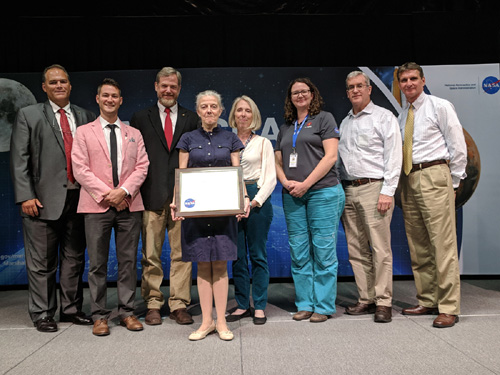
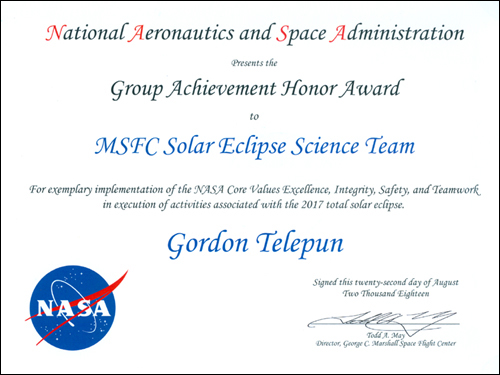
Since the 2017 total solar eclipse was basically a local eclipse for me, it enabled me to plan eclipse research projects that have been in my mind for many years as I have concentrated on the techniques of eclipse observing.
For the 2017 eclipse, I was designated a NASA Subject Matter Expert on the eclipse and was trusted with doing public outreach and education about enjoying the eclipse and observing it safely. On August 22, 2018, I was excited to be acknowledged as part of the NASA, Marshall Space Flight Center Solar Eclipse Science Team (I am furthest to the right). I contributed by teaching eclipse photography to the NASA team, helping with the understanding of shadow bands and assisting in designing shadow band observation plans for the NASA supervised students. Accepting the award is our team lead, NASA Astrophysicist Mitz Adams, who worked incredibly hard on many projects up to the eclipse. Mitzi is also a co-author on my article about observing shadow bands which will be published in a book by the Astronomical Society of the Pacific. It was an honor to be part of this team, of which only a portion is shown in the photo. {NASA or its employees cannot endorse commercial products}
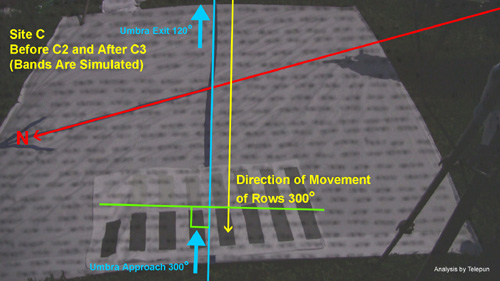
I was able to make a scientific contribution to the understanding of shadow bands during this eclipse. Because of my pre-planning with shadow band observation techniques and coordinating this with my NASA friends, I managed to obtained shadow band videos, with documented orientation, from three sites along the path in the southeast. The analysis of this data revealed that shadow bands are indeed affected by the motion of the atmosphere and the atmosphere can alter the angle of the rows of shadow bands observed on the ground. This research will be published by the Astronomical Society of the Pacific in a book reviewing the 2017 eclipse. My coauthors will be three of my NASA friends, two solar astrophysicists, and a NASA optical physicist. My research regarding shadow bands is covered in two of my YouTube videos which can be seen here and here.
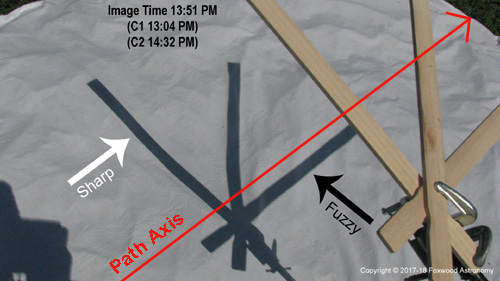
I also designed an experimental model to better demonstrated the partial phase phenomena of the creation of sharp and fuzzy shadows during an eclipse. As the partial phase of an eclipse progress, the sunlight begins to reach the Earth in a more linear fashion. This changes the way shadows are cast to the ground. After about a 50% partial phase, objects that are in-line with the crescent and cast a shadow, create shadows that are sharp at the edges, while objects that are perpendicular to the crescent create shadows that are fuzzy at the edges. It's an amazing effect that can only be seen during a solar eclipse. My experimental model can now be reproduced by others at upcoming eclipses and we can continue to document this effect in an organized and reproducible way. This experiment will be published by the Astronomical Society of the Pacific in a book reviewing the 2017 eclipse. Learn more about this amazing phenomena by watchin a video here.
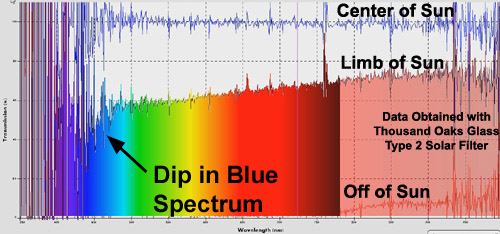
The change in ambient lighting in the 2 to 3 minutes before totality is amazing to behold. Being in the path of a total solar eclipse is the only place on Earth that you can witness this effect. I've uploaded two detailed YouTube videos about the change in ambient lighting. I am working to add to the understanding of the percieved color spectrum change by documenting the solar limb color spectrum that actually reaches Earth and integrate this information with what is know about the eye-brain system of color perception. My early research data reveals that light ofrm the solar limb that reaches Earth has a drop off in the blue specturm. This has impact on the Purkinje Effect which is related to the funtion of our retina's cones and rods as the level of light decreaes. I have more work to do on this subject. Eclipse ambient light change videos are here and here.
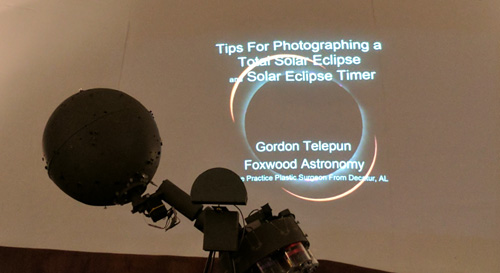
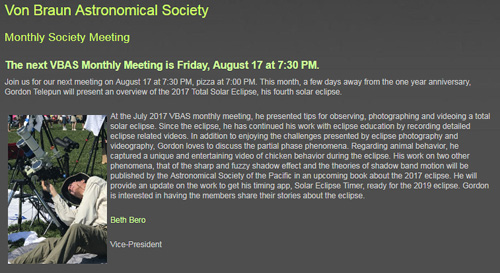
As part of my public outreach prior to the 2017 United States total solar eclipse I gave a number of lectures on eclipse preparation and eclipse photography lectures. And it was an honor to be invited to speak at the Von Braun Astronomical Society in Huntsville, Alabama. The society has a rich history that dates back to its organization in 1954 and having Dr. Wernher von Braun be it first president in 1955. Many of the early Redstone Arsenal rocketeers who built the Saturn V rocket that got us to the Moon have been members through time.
In June of 2017, I gave the members an eclipse photography and eclipse preparation talk. In August of 2018, I was invited back to give them a review of the Great American Eclipse, including my research projects.
Copyright 2002 - 2019 Gordon Telepun and Foxwood Astronomy, LLC
Solar Eclipse Timer and the Solar Eclipse Timer logos are Resistered Trademarks of Gordon Telepun.
The Solar Eclipse Timer banner art and all other art related to the Solar Eclipse Timer website and mobile applications are protected by copyright.